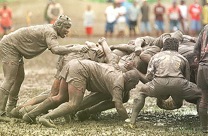By Dr Tim McEwen
 As an enthusiastic rugby player and a newly qualified Doctor, I am often asked by teammates what is the safest position on the rugby pitch. Is the assumption that playing on the wing is for wimps who don’t want to get hurt?
As an enthusiastic rugby player and a newly qualified Doctor, I am often asked by teammates what is the safest position on the rugby pitch. Is the assumption that playing on the wing is for wimps who don’t want to get hurt?
Rugby Union is growing in popularity, yet there is often a preconception that it can be dangerous and serious injuries are likely to occur, especially in certain positions. Interestingly, research indicates that the amateur game has a similar incidence and severity of injury to football and a much lower game injury ratio than other high intensity collision sports such as American football.
Within the game of rugby, analysis in the amateur game has found that flankers (men) and centres (women) were the most frequently injured during games, with the highest percentages of major injuries (causing more than 7 days training or matches to be missed) reported to be for the No 8 position (men and women). Fly halves and fullbacks were the least often injured in the men’s game whilst the scrum half got off lightest in the women’s game. In terms of injuries in training, it is bad news for any amateur men with presentations to do at work the following day as the head/face is the source of most complaints, whilst women suffer more knee injuries[i].
There has been far more research and analysis into the injury profiles of different positions within the professional game. Studies have shown that for every match 33 days of absence are incurred for forwards, and 28 days for backs. Forwards tend to suffer from shoulder, knee and ankle/heel problems whilst the lighter but fleeter of foot backs suffered most frequently from shoulder, hamstring and knee problems[ii].
Following concerns about injuries in the forwards and wasted game time due to the resetting of scrums, the International Rugby Board recently set up an expert Scrum Steering Group to give advice on law changes and referee instructions[iii]. Experimental law changes were brought in for the scrum at the start of the 2012/13 season. For this season, the instructions from the referee have been ‘crouch, touch, set’. Front rows crouch then touch and using their outside arm touch the point of the opposing prop’s outside shoulder. The props then withdraw their arms and the referee calls ‘set’ when the front rows are ready. The front rows will then set the scrum.
The RFU, in conjunction with the University of Bath, is currently undertaking a second study to see how the scrum can be further improved by looking at other engagement techniques, from this crouch, touch and set approach to a modified technique so that props maintain the touch before a deemphasised engagement technique.
Results are due this year with a focus on player welfare and trying to improve player, coach and referee education around scrummaging technique. At a time when there has been significant controversy regarding the understanding and refereeing of the scrum from within the professional game[iv][v], results are eagerly expected.
[i] Kerr HA, Curtis C, Micheli LJ et al. Collegiate rugby union injury patterns in New England: a prospective cohort study. Br J Sports Med;42:595-603.
[ii] Brooks JHM, Kemp SPT, Injury-prevention priorities according to playing position in professional rugby union players. Br J Sports Med 2011; 45:765-775.
[v] http://www1.skysports.com/rugby-union/news/12549/8371104/Leicester-Tigers-boss-Richard-Cockerill-left-fuming-by-scrum-decisions
**********************************************
Dr Tim McEwen is a Foundation Year 1 Doctor in the South Thames Deanery. He currently works at East Surrey Hospital. A former Harlequins U19 and U21 player, he now plays for Guildford RFC.